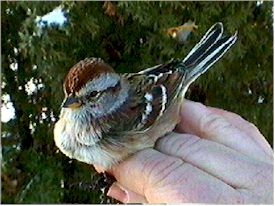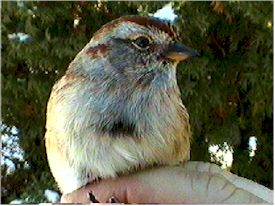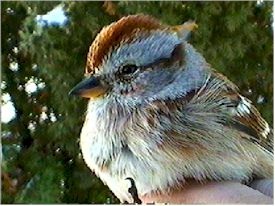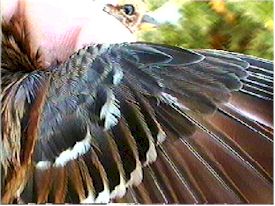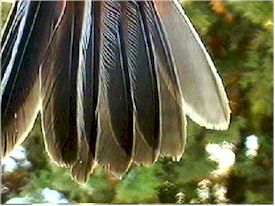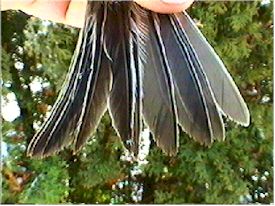American Tree Sparrow(Spizella arborea) General InformationThe American Tree Sparrow is one of the seven
species of Spizella sparrows found in North America. Its name is
misleading as they spend little time in trees. Related species
include the Chipping, Field, Black-chinned, Brewer’s and
Clay-colored Sparrows.
|
|
The American Tree Sparrow is a medium sized sparrow with a rufous crown, and a clear breast with a central dark spot. It is about 6 inches long with a wingspan of 8.5 to 9.75 inches. Weights range from around 18 to 26 grams. Sexes are similar. Juvenile birds show more streaking on the face and breast.
|
|
|
|
The distinctive field mark of the Tree Sparrow is the clear breast with a central black spot like a stick pin tie tack. |
|
Another good field mark is the yellow lower mandible. A rusty line extends behind the eye, and two white wing bars stand out on a warm rusty brown wing. |
|
|
|
Covert feathers of an adult bird are rufous, black and white. Adult primary coverts also shown here (right center) have rounded tips. |
|
Adult tail feathers are also rounded. |
|
|
|
Tail feathers of the juvenile bird are more pointed and are often worn and chipped. These are the first set of feathers grown in the nest and will be replaced during the first molt that occurs after the first breeding season. |
Nesting BehaviorAmerican Tree Sparrows breed in shrubby habitat along the edges of the tundra and northern tree limit. The nest of grass, weeds, feathers and hair, built by the female, is usually placed on or near the ground at the base of a small tree, shrub or tuft of grass. From 3 to 5 eggs incubated by the female hatch in about two weeks. Both parents care for the young, who leave the nest in 9 to 10 days. Banding RecoveriesThe Bird Banding Lab web site reports that between 1955 and 1997, a total of 404,923 American Tree Sparrows were banded. Of these, 12,751 have been recovered, a recovery rate of 3.14%. Banding studies show that the American Tree
Sparrow can live from 6 to 9 years in the wild. They are short
to long distance migrants that winter across most of the USA,
and migrate from 1,500 to 3,000 miles to their breeding grounds
in Alaska and northern Canada. Economic Importance &
|
